You can download our resources from here:
...
Lecture notes are in PDF format
Return Return to home page
| Panel |
|---|
| bgColor | white |
|---|
| titleBGColor | cream |
|---|
|
| Background Color |
|---|
| Our Webinars (recordings) |
| Section |
|---|
| Column |
|---|
| | Panel |
|---|
| bgColor | white |
|---|
| title | Sources of Uncertainties | Statistical postprocessing |
|---|
| 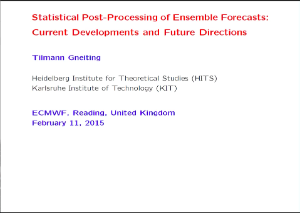 Image Added Image Added
Statistical post-processing of ensemble weather forecasts: Current developments and future directions (Tilmann Gneiting) - Statistical post-processing techniques serve to improve the quality of numerical weather forecasts, as they seek to generate calibrated and sharp predictive distributions of future weather quantities and events. I will review the state of the art in post-processing, with focus on ensemble forecasts and ongoing joint work between the ECMWF and the Computational Statistics group at the Heidelberg Institute for Theoretical Studies (HITS). Current and future challenges include the treatment of extreme events, and the calibration of probabilistic forecasts of combined events and spatio-temporal weather trajectories, for which discrete copula based techniques, such as ensemble copula coupling (ECC) and the Schaake shuffle, are attractive options.  Image Removed Image Removed
The aim of this webinar is to introduce the main sources of uncertainty that lead to forecast errors. The weather prediction problem will be discussed, and stated it in terms of an appropriate probability density function (PDF). The concept of ensemble prediction based on a finite number of integration will be introduced, and the reason why it is to be the only feasible method to predict the PDF beyond the range of linear growth will be illustrated.This Webinar was delivered by Dr. Roberto Buizza and recorded in May 2014. Click here to download the recording. |
|
| Column |
|---|
| | Panel |
|---|
| bgColor | white |
|---|
| title | Ensemble Data Assimilation |
|---|
|  Image Removed Image Removed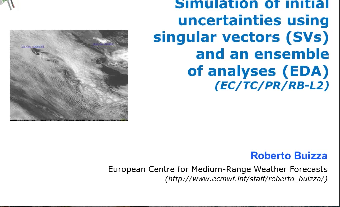 Image Added Image Added
The aim of this webinar is to introduce the ECMWF ensemble of data assimilation (EDA). The rationale and methodology of the EDA will be illustrated, and its use in to simulate initial uncertainties in the ECMWF ensemble prediction system (ENS) will be presented.This webinar was delivered by Dr. Roberto Buizza and recorded in May 2014. Click here to download the recording. |
|
| Column |
|---|
| | Panel |
|---|
| bgColor | white |
|---|
| title | Multi-model ensemble predictions on seasonal timescale |
|---|
|  Image Removed Image Removed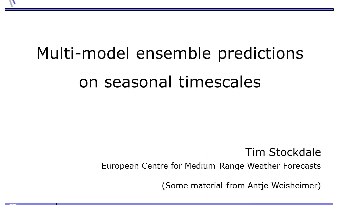 Image Added Image Added
This lecture looks at calibration and multi-model ensembles from a seasonal forecasting perspective. The theoretical basis is given, followed by research results that strongly motivated a multi-model approach for these timescales. The operational EUROSIP multi-model system is described. This Webinar was delivered by Dr. Tim Stockdale and recorded in May 2014. Click here to download the recording. |
|
|
| Expand |
|---|
| title | CLICK HERE FOR MORE RECORDINGS..... |
|---|
| | Section |
|---|
| Column |
|---|
| | Panel |
|---|
| bgColor | white |
|---|
| title | Introduction to surface processes |
|---|
|  Image Removed Image Removed Image Added Image Added This Webinar was delivered by Dr. Gianpaolo Balsamo and recorded in May 2013. It is an introduction to surface processes that are relevant for NWP models. Click here to download the recording. |
|
| Column |
|---|
| | Panel |
|---|
| bgColor | white |
|---|
| title | Data assimilation of surface parameters (part 1) |
|---|
|  Image Removed Image Removed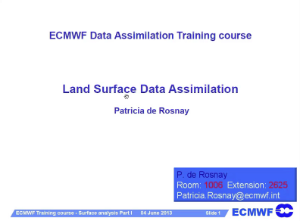 Image Added Image Added This webinar was delivered by Dr. Patricia De Rosnay and recorded in May 2013. It is the first of two webinars on Data Assimilation for surface parameters. It covers assimilation techniques used at ECMWF. Click here to download the recording. |
|
| Column |
|---|
| | Panel |
|---|
| bgColor | white |
|---|
| title | Data assimilation of surface parameters (part 2) |
|---|
|  Image Removed Image Removed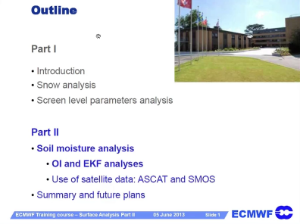 Image Added Image Added This webinar was delivered by Dr. Patricia De Rosnay and recorded in May 2013. It is the second of two webinars on Data Assimilation for surface parameters. It covers assimilation techniques used at ECMWF. Click here to download the recording. |
|
|
| Section |
|---|
| Column |
|---|
| | Panel |
|---|
| bgColor | white |
|---|
| title | Extra-tropical cyclones and their tracking |
|---|
|  Image Removed Image Removed Image Added Image Added
This Webinar was delivered by Mr. Tim Hewson and recorded in February 20142015. The process by which extra tropical cyclones are identified and tracked in the ECMWF IFS analyses and forecasts will be described, and this will be followed by an overview of the multi-faceted web products that relate, and how to use them. Reference will also be made to objective fronts. Click here to download the recording (Lecture slides are available here) |
|
| Column |
|---|
| | Panel |
|---|
| bgColor | white |
|---|
| title | Monthly Forecast |
|---|
|  Image Removed Image Removed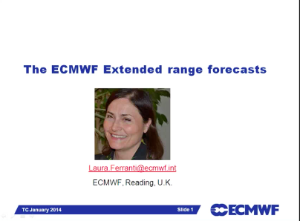 Image Added Image Added
This Webinar was delivered by Dr. Laura Ferrati and recorded in February 20142015. This presentation is an introduction to the ECMWF Extended range forecasts. The main sources of predictability at the sub-seasonal time scale will be introduced. The ECMWF forecasting system will be discussed as well as its products and its past performance. Click here to download the recording. (Lectures slides are available from here) |
|
| Column |
|---|
| | Panel |
|---|
| bgColor | white |
|---|
| title | Seasonal Forecast at ECMWF |
|---|
|  Image Removed Image Removed Image Added Image Added
This Webinar was delivered by Dr. Laura Ferrati and recorded in February 2013. It describes the Seasonal Forecasting system at ECMWF, its products and their interpretation. Click here to download the recording. |
|
|
| Section |
|---|
| Column |
|---|
| | Panel |
|---|
| bgColor | white |
|---|
| title | Coud and precipitation: from model to forecasting |
|---|
|  Image Removed Image Removed Image Added Image Added
This Webinar was delivered by Dr. Richard Forbes and recorded in February 20142015. This seminar will describe how cloud and precipitation is represented in the ECMWF global model with examples of model evaluation against different types of observations and strengths and weaknesses highlighted. The cloud related forecast products are discussed with some insights into interpretation in different meteorological situations. By the end of this seminar you should be able to: 1. Describe how cloud and precipitation is represented in the ECMWF global model 2. Recognise some of the strengths and weaknesses of the forecast cloud/precipitation. 3. Interpret cloud and precipitation related forecast products. Click here to download the recording. (Lectures slides are available from here) |
|
| Column |
|---|
| | Panel |
|---|
| bgColor | white |
|---|
| title | Understanding the model climate |
|---|
|  Image Removed Image Removed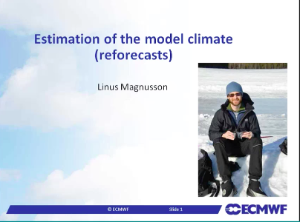 Image Added Image Added
This Webinar was delivered by Dr. Linus Magnuson and recorded in February 20142015. The aim the lecture is to give a motivation for why ECMWF produces a data set for the model climate, explain the configuration of it and discuss some of the strengths and weaknesses (limitations). In the lecture we will also explain the cumulative distribution function of the model climatology, as a background for the extreme forecast index (EFI). Click here to download the recording. (Lectures slides are available from here). |
|
| Column |
|---|
| | Panel |
|---|
| bgColor | white |
|---|
| title | Model errors and diagnostic tools |
|---|
|  Image Removed Image Removed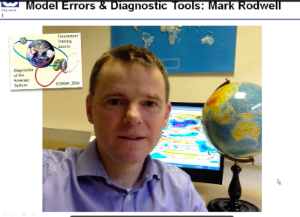 Image Added Image Added
This webinar was delivered by Dr. Mark Rodwell and recorded in February 20142015. Diagnostics at ECMWF is about looking for weaknesses in the forecasting system, trying to identify their causes, working with developers, and documenting the resulting changes in performance. As observation volumes increase, and models get more complex, accurate and represent smaller-scale weather features, and as the need for uncertainty information grows, diagnostic tools need to be ever more powerful and precise. Here, with the help of a few case studies, I will discuss the development of these tools, and how they are helping us identify residual deficiencies. Click here to download the recording. (Lectures slides are available from here). |
|
|
| Section |
|---|
| Column |
|---|
| | Panel |
|---|
| bgColor | white |
|---|
| title | Forecasting extreme events |
|---|
|  Image Removed Image Removed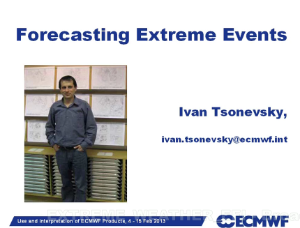 Image Added Image Added This webinar was delivered by Mr. Ivan Tsonevsky and recorded in February 20142015. The Extreme Forecast Index (EFI) has been developed at ECMWF to alert forecasters to anomalous or extreme weather events by comparing the Ensemble Forecasts (ENS) with the model climate as a reference. The Shift Of Tails (SOT) was implemented in 2012 to complement the EFI by providing additional information about the extremity of a given weather event. This talk will give an overview of the use and interpretation of the EFI and SOT for forecasting extreme weather. It will provide information about some limitations of the EFI products and the future plans in the severe weather forecasting at ECMWF. A lot of practical examples will be used throughout the talk to explain and clarify different aspects of the EFI products in forecasting hazardous and anomalous weather events. Click here to download the recording. (Lectures slides are available from here). |
|
|
|
|
| titleBGColor | cream| Background Color |
|---|
| Our Slidecasts (slides and audio recordings) |
 Image Added Image Added
The aim of this webinar is to introduce the main sources of uncertainty that lead to forecast errors. The weather prediction problem will be discussed, and stated it in terms of an appropriate probability density function (PDF). The concept of ensemble prediction based on a finite number of integration will be introduced, and the reason why it is to be the only feasible method to predict the PDF beyond the range of linear growth will be illustrated.This Webinar was delivered by Dr. Roberto Buizza |
|
|
| | Section |
|---|
| Column |
|---|
| | Panel |
|---|
| bgColor | white |
|---|
| title | Sources of predictability beyond the deterministic limit |
|---|
|  Image Removed Image Removed
This lecture was delivered by Mr. Franco Molteni and recorded in May 2014. Click here to download the recording |
|
| Column |
|---|
| | Panel |
|---|
| bgColor | white |
|---|
| title | Teleconnections and interannual variability of the atmosphere |
|---|
|  Image Removed Image Removed
This lecture was delivered by Mr. Franco Molteni and recorded in May 2014. Click here to download the recording. |
|
|
|
|
| Panel |
|---|
| bgColor | white |
|---|
| titleBGColor | cream |
|---|
|
| Background Color |
|---|
| Our Slidecasts (slides and audio recordings) |
| Section |
|---|
| Column |
|---|
| | Panel |
|---|
| bgColor | white |
|---|
| title | Sources of predictability beyond the deterministic limit |
|---|
|  Image Added Image Added
| | title | Weather Regimes |
|---|
 Image Removed Image Removed
This lecture was delivered by MrDr. Franco Molteni and recorded in May 2014. Click here to download the recording |
|
| | Expand |
|---|
| title | CLICK HERE FOR MORE RESOURCES..... |
|---|
| | Column |
|---|
| | Panel |
|---|
| bgColor | white |
|---|
| title | Teleconnections and interannual variability of the atmosphere |
|---|
|  Image Added Image Added
This lecture was delivered by Dr. Franco Molteni and recorded in May 2014. Click here to download the recording |
| section |
| Column |
|---|
| | Panel |
|---|
| bgColor | white |
|---|
| title | Weather Regimes |
|---|
| 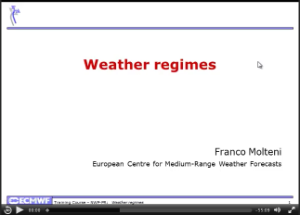 Image Added Image Added
This lecture was delivered by Dr. Franco Molteni and recorded in May 2014. Click here to download the recording |
|
|
| Expand |
|---|
| title | CLICK HERE FOR MORE RESOURCES..... |
|---|
| | Section |
|---|
| Column |
|---|
| | Panel |
|---|
| bgColor | white |
|---|
| title | Towards an earth system model |
|---|
| 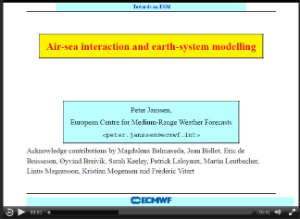 Image Added Image Added
Recently, there is in increasing interest in trying to understand the properties of coupled atmosphere, ocean-wave, ocean/sea-ice models with an ultimate goal to start predicting | Towards an earth system model |  Image Removed Image Removed
Recently, there is in increasing interest in trying to understand the properties of coupled atmosphere, ocean-wave, ocean/sea-ice models with an ultimate goal to start predicting weather, waves and ocean circulation on time scales ranging from the medium-range to seasonal timescale. Such a coupled system not only requires the development of an efficient coupled forecasting system but also the development of a data assimilation component.This lecture was delivered by Dr. Peter Jansen and recorded in May 2014. Click here to download the recording |
|
| Column |
|---|
| | Panel |
|---|
| bgColor | white |
|---|
| title | Seasonal Forecast at ECMWF |
|---|
|  Image Removed Image Removed Image Added Image Added
This lecture was delivered by Dr. Laura Ferrati and recorded in February 2014. It describes the Seasonal Forecasting system at ECMWF, its products and their interpretation. Click here to download the recording (the lecture in pdf format can be downloaded here). |
|
| Column |
|---|
| | Panel |
|---|
| bgColor | white |
|---|
| title | Forecasting tropical cyclones in the medium range |
|---|
|  Image Removed Image Removed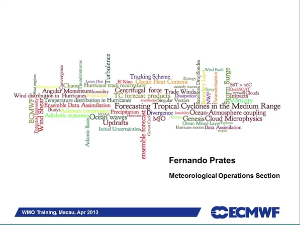 Image Added Image Added
This lecture was delivered by Mr. Fernando Prates and recorded in February 20142015. It describes the tropical cyclone tracker and ECMWF ensemble products for forecasting tropical cyclones. Click here to download the recording (the lecture in pdf can be downloaded here). |
|
|
| Section |
|---|
| Column |
|---|
| | Panel |
|---|
| bgColor | white |
|---|
| title | Physical Processes in NWP models | Ensemble forecasting: can they help making decisions? |
|---|
| 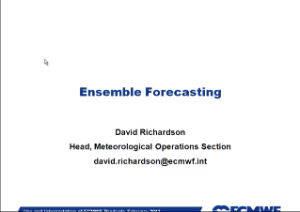 Image Added Image Added Image Removed Image Removed
This lecture was delivered by DrMr. Peter Bechtold David Richardson and recorded in February 20142015. It describes the physical processes in NWP models with special emphasis on ECMWF forecasting systemsECMWF ensemble prediction system and how it can be used in the decision making process. Click here to download the recording (the lecture in pdf can be downloaded here). |
|
| Column |
|---|
| | Panel |
|---|
| bgColor | white |
|---|
| title | Forecasting Waves |
|---|
|  Image Removed Image Removed Image Added Image Added
This lecture was delivered by Dr. Jean Bidlot and recorded in February 2014. It describes ECMWF wave model and its products. Click here to download the recording (the lecture in pdf can be downloaded here). |
|
| Column |
|---|
| | Panel |
|---|
| bgColor | white |
|---|
| title | Monitoring satellite observations |
|---|
|  Image Removed Image Removed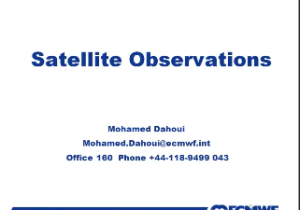 Image Added Image Added
This lecture was delivered by Dr. Mohamed Dahoui and recorded in February 20142015. It shows the satellite monitoring techniques with specific emphasis on ECMWF monitoring suite. Click here to download the recording (the lecture in pdf can be downloaded here). |
|
|
| Section |
|---|
| Column |
|---|
| | Panel |
|---|
| bgColor | white |
|---|
| title | Data assimilation |
|---|
|  Image Removed Image Removed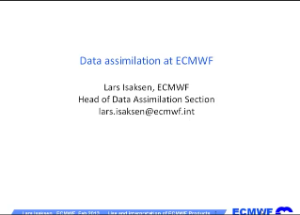 Image Added Image Added
This lecture was delivered by Dr. Lars Isaksen and recorded in February 20132015. It describes the data assimilation system at ECMWF, and its future evolution. Click here to download the recording. |
|
| Column |
|---|
| | Panel |
|---|
| bgColor | white |
|---|
| title | ecCharts |
|---|
|  Image Removed Image Removed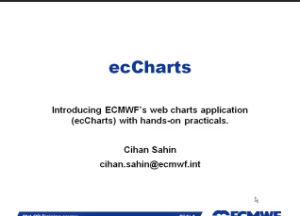 Image Added Image Added
This lecture was delivered by Mr. Cihan Sahin and recorded in February 2013. It is a basic introduction to a web based application called ecCharts to visualise ECMWF data. Click here to download the recording. |
|
| Column |
|---|
| | Panel |
|---|
bgColor |
|---|
| white | title | Ensemble forecasting: can they help making decisions? | Model Physics |
|---|
| 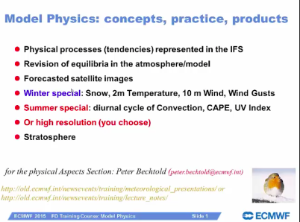 Image Added Image Added
The  Image Removed Image Removed
This lecture was delivered by Dr. Peter Bechtold during the training course in 2015. It reviews the physical parameterisation in the ECMWF model. Mr. David Richardson and recorded in February 2014. It describes ECMWF ensemble prediction system and how it can be used in the decision making process. Click here to download the recording (the lecture in pdf can be downloaded here). |
|
|
|
|
panel | bgColor | white
...
cream| Panel |
|---|
| Background Color |
|---|
| Our Tutorials (videos) |
| Section |
|---|
| Column |
|---|
| | Panel |
|---|
| bgColor | white |
|---|
| title | ECPDS Intro |
|---|
| The video shows what is ECPDS. Click here to see the video | |  Image Added Image Added
In this page you will find a collections of short videos on the main architecture behind ECPDS (ECMWF Production Dissemination System), main concepts supporting it and how to use it. The short videos describe the main functionalities of ECPDS to help getting started with the system. Click here to go to the ECPDS tutorial page |
|
| Column |
|---|
| | Panel |
|---|
| bgColor | white |
|---|
| title | Login - Status (7 min) | | ecFlow |
|---|
| ecFlow is a work flow package that enables users to run a large number of programs (with dependencies on each other and on time) in a controlled environment. It provides reasonable tolerance for hardware and software failures, combined with good restart capabilities. It is used at ECMWF to around half our operational suites across a range of platforms. Click here to start the online tutorial  Image Removed Image Removed
The video shows how to log in to ECPDS, start and stop and status of a destination. Click here to see the video |
|
| Column |
|---|
| | Panel |
|---|
| bgColor | white |
|---|
| title | Data file filters (5 min) | Metview |
|---|
|  Image Added Image Added
Metview is a meteorological workstation application designed to be a complete working environment for both the operational and research meteorologist. Its capabilities include powerful data access, processing and visualisation.  Image Removed Image Removed
The video explains the file filters available in ECPDS and how to see the volumes in dissemination. Click here to see go to the videoonline tutorials |
|
|
|
| Panel |
|---|
| Background Color |
|---|
| Our training lectures (presentations in PDF) |
| Section |
|---|
| Column |
|---|
| | Panel |
|---|
| bgColor | white |
|---|
| title | ECMWF computing services, archiving and software - 2017 |
|---|
| The courses aim to introduce participants to ECMWF's new computing services and software: Click here to browse the presentations for "Introduction to ECMWF computing and the Meteorological Archival and Retrieval System" Click here to browse the presentations for "ecCodes: GRIB encoding and decoding software" Click here to browse the presentations for "High Performance Computing Facility: Cray XC40" |
|
| Column |
|---|
| | Panel |
|---|
| bgColor | white |
|---|
| title | NWP lectures - 2017 |
|---|
| The objective of the meteorological training course is to assist Member States in advanced training in the field of numerical weather forecasting. The course is divided into modules covering different aspects of NWP: Data Assimilation, Predictability and ocean-atmosphere ensemble forecasting, Parametrization of surged physical processes, Advanced numerical methods for Earth-system modelling. Click here to browse the presentations (not yet available) |
|
| Column |
|---|
| | Panel |
|---|
| bgColor | white |
|---|
| title | Use and Interpretations of ECMWF products - 2017 |
|---|
| This course provides theoretical background information on ECMWF forecasting system and hands on experience in using ECMWF meteorological products both in the forecasting room and in making more informed decisions when weather plays a key role. Click here to browse the presentations |
|
|
| Expand |
|---|
| title | CLICK HERE FOR MORE RESOURCES... |
|---|
| | Section |
|---|
| Column |
|---|
| | Panel |
|---|
| bgColor | white |
|---|
| title | ECMWF computing services, archiving and software - 2016 |
|---|
| The courses aim to introduce participants to ECMWF's new computing services and software: Click here to browse the presentations for "Introduction to ECMWF computing and the Meteorological Archival and Retrieval System" Click here to browse the presentations for "ecCodes: GRIB and BUFR encoding and decoding software" Click here to browse the presentations for "High Performance Computing Facility: Cray XC30" |
|
| Column |
|---|
| | Panel |
|---|
| bgColor | white |
|---|
| title | NWP lectures - 2016 |
|---|
| The objective of the meteorological training course is to assist Member States in advanced training in the field of numerical weather forecasting. The course is divided into modules covering different aspects of NWP: Data Assimilation, Predictability and ocean-atmosphere ensemble forecasting, Parametrization of surged physical processes, Advanced numerical methods for Earth-system modelling. Click here to browse the presentations |
|
|
| | Expand |
|---|
| title | CLICK HERE FOR MORE VIDEOS..... |
|---|
| | Section |
|---|
| Column |
|---|
| | Panel |
|---|
| bgColor | white |
|---|
| title | Requeue files (10 min) | Use and Interpretations of ECMWF products - 2016 |
|---|
| This course provides theoretical background information on ECMWF forecasting system and hands on experience in using ECMWF meteorological products both in the forecasting room and in making more informed decisions when weather plays a key roleThe video explains the transfer table and how to requeue files, change priorites, extend lifetime ... Click here to see browse the videopresentations |
|
|
| Section |
|---|
| Column |
|---|
| | Panel |
|---|
| bgColor | white |
|---|
| title | Host Configuration / Traceroute (3 min) | ECMWF Cray supercomputing services - 2015 |
|---|
| The course aims to introduce participants to ECMWF's new Cray supercomputing services, covering those areas of optimisation that will help the student to make more efficient use of the system and avoiding the areas which may adversely impact overall system performanceThe video explains how to see host configuration, activate/deactivate hosts, make traceroute/ping. Click here to see browse the videopresentations |
|
| Column |
|---|
| | Panel |
|---|
| bgColor | white |
|---|
| title | File Errors (3 min) |
|---|
| The video shows how to look at file - info and transfer errors. Click here to see the video |
|
| section| ECMWF computing and software services - 2015 |
| The courses aim to introduce participants to ECMWF's new computing services and software: Click here to browse the presentations for "Introduction to ECMWF computing and the Meteorological Archival and Retrieval System" Click here to browse the presentations for "GRIB API" |
|
| Column |
|---|
| | Panel |
|---|
| bgColor | white |
|---|
| title | Timeline (3 min) | Use and Interpretations of ECMWF products - 2015 |
|---|
| This course provides theoretical background information on ECMWF forecasting system and hands on experience in using ECMWF meteorological products both in the forecasting room and in making more informed decisions when weather plays a key roleThe video shows the timeline funtionality, which allows to identify problems with transfers when they take longer than usual. Click here to see the videobrowse the presentations Click here to browse the videos
|
|
|
| Section |
|---|
| Column |
|---|
| | Panel |
|---|
| bgColor | white |
|---|
| title | Monthly and Seasonal Files (3.5 min) | Introduction for new users including MARS - 2014 |
|---|
| The aim of this module is to introduce students to ECMWF's basic computing services, both the workstation system (ecgate) and the data storage/archive facility. MARS is the Centre's meteorological data archive. This course is aimed at new users of ECMWF's computer servicesThis video shows how to find the monthly, hindcast and seasonal files in ECPDS. Click here to see browse the videopresentations |
|
|
|
|
| titleBGColor | cream |
|---|
| title | Our Lecture Notes (PDF) -- AVAILABLE SOON! |
|---|
| The objective of the meteorological training course is to assist Member States in advanced training in the field of numerical weather forecasting. The course is divided into modules covering different aspects of NWP: Data Assimilation, Predictability and ocean-atmosphere ensemble forecasting, Parametrization of subgrid physical processes, Advanced numerical methods for Earth-system modelling. - Data Assimilation: Click here to browse presentations
- Predictability and ocean-atmosphere ensemble forecasting: Click here to browse presentations
- Parametrization of subgrid physical processes: Click here to browse presentations
- Advanced numerical methods for Earth-system modelling: Click here to browse presentations
|
|
|
| | Section |
|---|
|
|
...
| title | GRIB API: library and tools - 2014 |
|---|
| GRIB API is a GRIB decoding/encoding software developed at ECMWF. It supports GRIB edition 1 and 2 with the same function calls and has both a Fortran interface and C interface. Click here to browse the presentations |
|
|
|
|



























